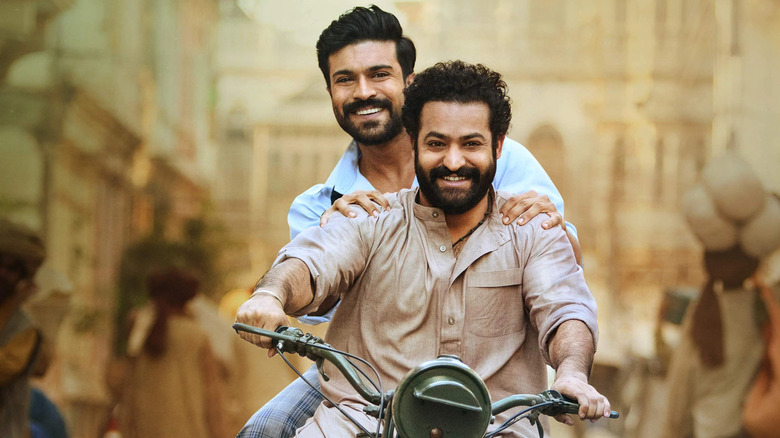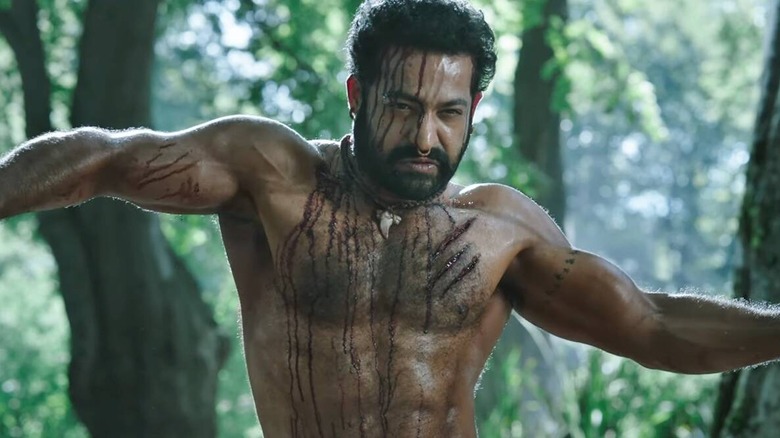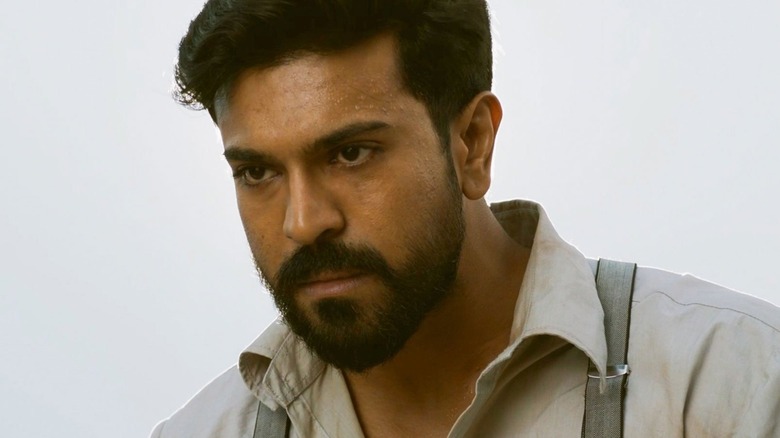The Real-Life Inspirations Behind The Characters In RRR
S.S. Rajamouli has quickly become something of a household name in the last few months, thanks to the sudden success of his enormous — and enormously entertaining — "RRR," a sprawling three-hour action epic that features fights, gun battles, wild animal attacks, superhuman feats of strength and stamina, and more than a few upbeat dance numbers. Very occasionally, an American audience will discover the awesomeness of Indian cinema — the author is old enough to recall the stateside stir caused by Ashutosh Gowariker's "Lagaan" back in 2005 — and those in the know are happy to share their enthusiasm. Perhaps the success of "RRR" will lead audiences to seek out Rajamouli's other films, other Tollywood actioners, and more Indian films in general.
Set in 1920, "RRR" creates a fictional team-up between real-life Indian revolutionaries Alluri Sitarama Raju (Ram Charan) and Komaram Bheem (N.T. Rama Rao, Jr.), positing a fictional version of their lives wherein they built a fast friendship, had a severe falling out over their involvement with the Raj (Raju is depicted as the Raj's most badass cop), and then eventually reunite to attack and take down the British colonialists. "RRR" plays like a "Fast & Furious" movie, but Dom and his family were recognizable historical figures.
"RRR" ends with an extended song-and-dance number, "Etthara Jenda," that memorializes notable revolutionary figures of Indian history, including Subhas Chandra Bose, Sardar Vallabhbhai Patel, and Bhagat Singh. Also in the montage are inspirational rulers from Indian history, Rani Laxmi Bai and Chhatrapati Shivaji Maharaj. The story is so fanciful that the filmmakers felt it necessary to include a disclaimer at the head of the film.
And who were Alluri Sitarama Raju and Komaram Bheem? Read on, dear reader.
Komaram Bheem
In "RRR," the character of Komaram Bheem is depicted as a man immediately wronged by the British colonialists. When a young woman from his Gond village is kidnapped by a visiting British dignitary — he likes the way she sings — Bheem travels to Delhi to find her and rescue her. He is already seen as something of a folk hero, thanks to an extended sequence wherein he bests a tiger in hand-to-hand combat. Bheem is depicted as passionate, virtuous, and heroic, although his rage over oppression leads to several moments of extreme violence; Bheem lets loose a bus full of untrained animals onto a British estate.
The real Komaram Bheem was born in the Adilabad district of Telangana in 1901. He was, as in the movie, a member of the Gond tribe, and was raised in forests around Chanda and Ballalpur. This was at a time when the Gondi people were being persecuted by landlords, and Bheem had to go on the lam to avoid being apprehended by tax assessors. Bheem had always been involved in anti-Colonialist movements, joining a distributor of anti-British magazines for a spell before becoming a labor union organizer on a tea plantation in Assam. Bheem would surreptitiously join the Indian Communist party, and begin speaking out for an independent Gond country in various local districts, gathering a great many people together and leading an uprising against the landlords. His guerilla war lasted for years, and he was ultimately successful. Bheem was presumably murdered by a cop in 1940.
Allani Sridhar's 1990 film "Komaram Bheem" details the above parts of his life in detail — "RRR" takes place at a time in Bheem's life that is not well-recorded.
Alluri Sitarama Raju
In "RRR," Raju — sporting one of cinema's most amazing mustaches — is introduced battling and killing maybe 50 people in order to apprehend a single rioter that his British commanding officer was displeased with. He is assigned to track down the man, Bheem, whom the authorities happen to know is planning on rescuing the above-mentioned kidnapped girl. By coincidence, Raju and Bheem encounter one another in public, each not knowing the identity of the other, and hastily team up to rescue a young boy trapped under a burning bridge. They immediately become friends, setting up an inevitable betrayal when they each learn about each other's respective missions. He is stalwart, confident, capable, and eventually becomes bottomlessly principled.
The real Alluri Sitarama Raju was a contemporary of Komaram Bheem, born in the late 1890s in what is now Andhra Pradesh. Raju is known for an uprising surrounding the 1882 Madras Forest Act, an unjust ruling that banned the practice of shifting cultivation farming (more dramatically called slash-and-burn) that was vital to the local tribes' survival. It also, essentially, prevented tribes from moving throughout and out of the forests, keeping them prisoner. In 1922, Raju became a key figure in an uprising called the Rampa Rebellion which was a two-year-long violent insurrection pointed specifically at the injustice of the Forest Act. His fighting became legendary, and Raju earned the nickname of Manyam Veerudu, or Hero of the Jungle. The uprising ended with Raju being apprehended and put to death by firing squad.
Raju was also the subject of a Telugu biopic called simply "Alluri Seetarama Raju," directed by V. Ramachandra Rao, and released in 1974. It was the first Cinemascope film to be made in South India.
Did they meet?
There is no historical record of Raju or Bheem ever actually meeting in real life, and they certainly didn't team up to fight the Raj in a spectacular superhero-like showdown. "RRR" is an exciting action movie memorial to two respected Indian revolutionaries, reimagined as modern genre film archetypes. "RRR" may have no interest in historical accuracy, but it does respect Bheem's and Raju's legacies, showing them to be upstanding men in the face of grand historical oppression. "RRR" may just be a way to get wiggly junior high school-aged kids to take notice of Indian history, and perhaps delve a little bit more into how widespread and long-lasting Indian occupation was.
If there are any American analogs (for the American reader) one might look to a film like 2012's "The Raven" (which reimagined Edgar Allan Poe as teaming up with the police in order to investigate murders) or, to cite a more extreme example, "Abraham Lincoln: Vampire Hunter" (which was, indeed, about the 16th president learning to fight creatures of the night). Understanding of history, but "spiced up" with a fantasy element.
"RRR" isn't so fantastical as to include vampires, but it does a great job of depicting two real-world revolutionaries as unstoppable heroes devoted to undoing a great historical wrong. "RRR" happily pays homage to the men and women who fought for India and wrested it from Colonialist rule.
India achieved independence in 1947.



